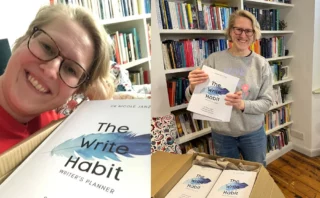Photo by Marvin Meyer on Unsplash
Boost Your Accountability and Creative Flow
“Writing is like running, or any kind of exercise: it can be motivating to share your experience with someone else.” — Joanne Harris, Ten Things About Writing
Writing can be isolating, and it’s hard to keep up the momentum with a busy schedule. This is especially true for entrepreneurs who want to enjoy creative flow while building their businesses.
I run a small co-writing group of entrepreneurs who meet for a short, 50-minute writing sprint once a week. During this time, I write articles like this one or my newsletter. Here’s how it works: we log into Zoom, set goals, and write quietly alongside each other — and at the end, we check out by stating what we’ve achieved.
It seems so simple. But at our first meeting, everyone was surprised at how easily they found flow. They had never heard of writing groups before, even though co-writing is common among fiction authors and academic writers.
Are you craving a community like that?
Here are five top tips to start your own entrepreneurial writing group and create your content faster.
Step 1: Find at least three people
“Creating supportive connections will help you do your research, write productively, publish effectively, and flourish.” — Joli Jensen, Write No Matter What
Find three or more to have a critical mass. At the same time, the smaller the group, the easier it is to schedule time to meet online. Where do you find co-writing partners? Try fellow entrepreneurs who publish articles, books, a podcast, or videos — they are all writing their content before it gets published, and they’re likely to be as lonely as you are. Use social media and professional networks to let others know you’re looking for writing partners. You’d be surprised how many creative entrepreneurs are looking for writing buddies.
Step 2: Allocate a facilitator
“Knowing that someone is watching can be a powerful motivator. You are less likely to procrastinate or give up.” — James Clear, Atomic Habits
Groups don’t run themselves — one person has to be the lead ‘facilitator.’ You will probably be that person for a while, but later you can rotate that task monthly. The facilitator sets a meeting time and sends around a Zoom (or other software) link and calendar invite.
At the start of the session, the facilitator asks the writers to share their goals (e.g. write 50% of a podcast episode; draft 600 words of a blog post). The facilitator then reminds everyone to turn off distractions (email, phone notifications, social media, etc.) and starts the timer. Everyone writes quietly alongside each other, the camera on or off, the microphone on mute. When the time ends, the facilitator asks everyone to report their progress to the group (for large groups, do it in the chat).
Step 3: Decide how long each session runs
For entrepreneurs with a busy schedule, I recommend a power hour of 50 minutes (with 10 minutes to set goals and debrief) at the start of the day. You can also write together for 90 minutes, depending on how long everyone in the group can concentrate and how much time they can schedule for writing. Stick to the set time each time, so that you train your brain for a specific length of focus time.
Step 4: Take breaks — make them mandatory
“Your brain will be working on your writing project while you are not writing.” — Rowena Murray, Writing for Academic Journals.
A 90-minute session of deep work is the longest most people can go. Sometimes you get into such a flow that you feel you want to keep going. You might be afraid you’ll jinx it and never get into the flow again when you stop.
The opposite is true. Once your brain knows it can get into the deep work zone, it will be able to repeat it again and again. But only if it’s not burned out. After a maximum of 90 minutes, I recommend taking 15 minutes away from the desk, hydrating and stretching. If you want to keep writing throughout the day, plan no more than four (better three) 90-minute sessions with at least 30-minute breaks in between. This will help you stay focused and keep up the energy.
Step 5: Track your progress and celebrate wins
“Without seeing progress, it’s all too easy to burn out and give up.“ — Dan Sullivan & Benjamin Hardy, The Gap and the Gain
Track your progress at the end of each session, and throughout the week. Did you achieve the goal you set for yourself at the start of a co-writing session? Make a quick note of what went well, and what didn’t. Tracking yourself helps you to set realistic goals next time. And celebrate your wins with the group will sustain your confidence and keep the inner critic quiet.
Even if your schedule is busy, give it a go. Harness the power of writing with others. Soon, you will start experiencing writing with focus, flow, and ease.


